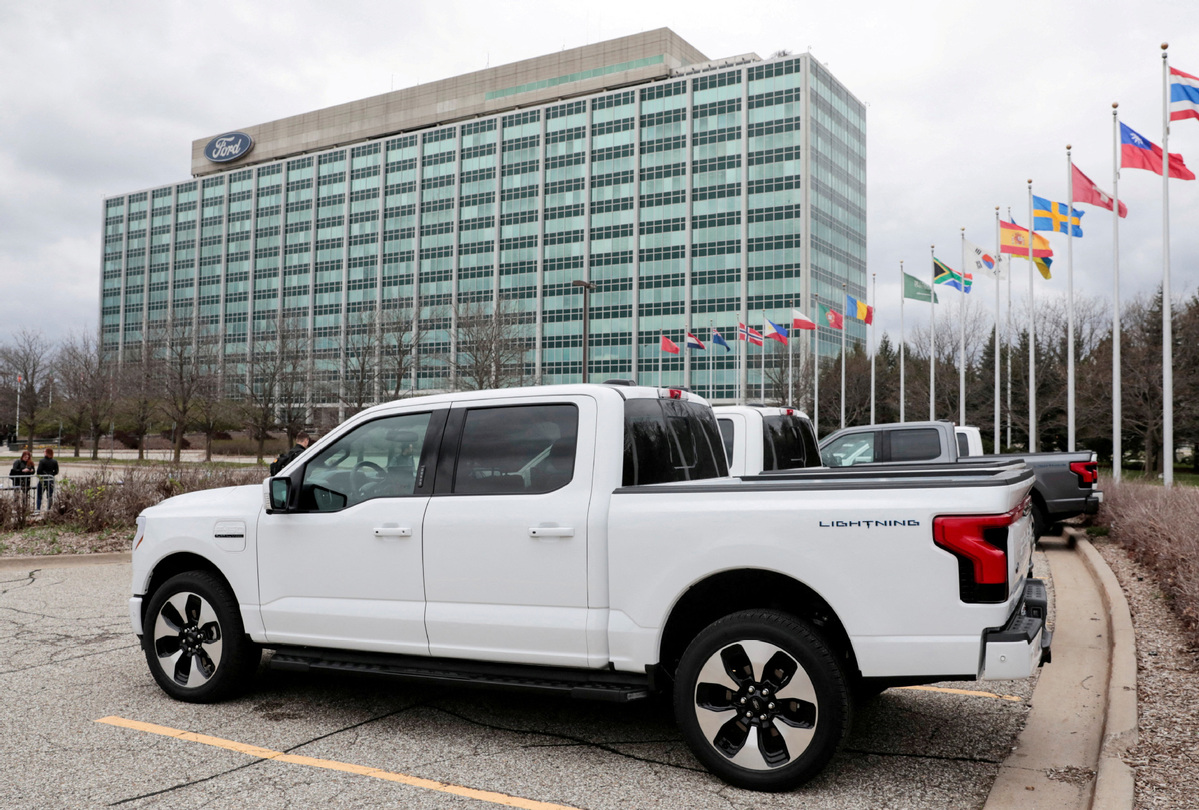
A model of the all-new Ford F-150 Lightning electric pickup is parked in front of the Ford Motor Company World Headquarters in Dearborn, Michigan, US April 26, 2022. [Photo/Agencies]
The Biden administration and automakers are in the final stages of negotiating ambitious new rules to accelerate the electric vehicle transition that could cost Detroit’s automakers billions and fuel an election-year clash over climate policy.
The White House could enact proposed Environmental Protection Agency regulations as soon as March that would mandate dramatic reductions in tailpipe emissions.
The administration proposal would require boosting the United States’ EV market share to 67 percent by 2032 from less than 8 percent in 2023.
General Motors, Ford and Stellantis — the European parent company of US-based Ram and Jeep — have warned that they cannot profitably transition their truck-heavy US fleets that quickly, according to a Reuters analysis of automakers’ sales data and a review of comments to regulators.
The United Auto Workers, which represents about 146,000 workers at the Detroit Three, has told the administration its drive for EVs puts jobs at risk.
Automakers endorsed an earlier administration target to boost EVs to 50 percent of new vehicle sales by 2030. Groups representing auto dealers have joined in the criticism of more ambitious targets, citing the slowdown in EV sales growth.
The Alliance for Automotive Innovation, which represents the Detroit Three and other established automakers, said the proposals could expose US automakers to $14 billion in fines for failing to hit the CO2 targets.
Ford, GM and Stellantis have urged the administration to reduce potentially costly conflicts among overlapping regulations administered by the Transportation Department, Energy Department and the state of California.
Those conflicts could result in “added costs for original equipment manufacturers that will impact jobs, capital investments, and ultimately the success of the transition” to EVs, said GM.
GM indicated in public comments that new emissions rules should allow for a slower ramp up of EV sales toward the 2032 goal. But GM also said Energy Department proposals to reduce emissions credits generated by EV sales “will result in disproportionately higher compliance costs for GM and the Detroit Three”.
Stellantis criticized the EPA in its written comments for “completely ignoring the market benefit of plug-in hybrid electric vehicles “technology. The automaker plans a plug-in hybrid Ram pickup and currently sells Jeep and Chrysler plug-in hybrid models.
“In a consumer environment that strongly favors light trucks, Stellantis introduced plug-in hybrid technology — a decision that is resonating in the US,” the company said in a statement Wednesday.
The EV price war launched by Tesla last year amplified Detroit’s concerns.
“You will have a bloodbath” as legacy automakers struggle to absorb high EV investment and production costs, Stellantis CEO Carlos Tavares told reporters in February.
The US EV market share trails far behind that of Europe and especially China.
Non-union Tesla dominates US EV sales. The unionized Detroit automakers trail far behind, with EVs accounting for only 4 percent of Ford’s total sales and 3 percent of GM deliveries.
Stellantis plans to launch eight EVs in the US by the end of 2024, including an all-electric Ram pickup and two Jeep EVs.
The problem for Detroit brands in meeting Biden’s proposed emissions curbs is their outsized reliance on their largest and least efficient vehicles: mid- and full-sized pickups and truck-based SUVs.
Such vehicles account for 46 percent of GM’s sales and 59 percent of those at Ford, a Reuters review of their 2023 sales by model shows.
Those figures do not include the automakers’ smaller, car-based crossover SUVs. The Ram and Jeep brands exclusively sell pickups and SUVs and accounted for 77 percent of Stellantis’ US sales last year.
Biden’s proposals could require the Detroit automakers to undertake extensive product or technological overhauls to comply.
GM had eschewed hybrids for the US market as a waste of resources. In February, however, GM Chief Executive Mary Barra said GM is now working on plug-in hybrids for the US market in response to rising sales of hybrids.
Both Ford and GM have struggled to sell their full-sized EV pickups.
Ford in January cut 2024 production of the F-150 Lightning to one shift, reversing earlier plans to accelerate to three shifts daily.
GM’s new Silverado EV sold just 461 units last year.
Reuters
